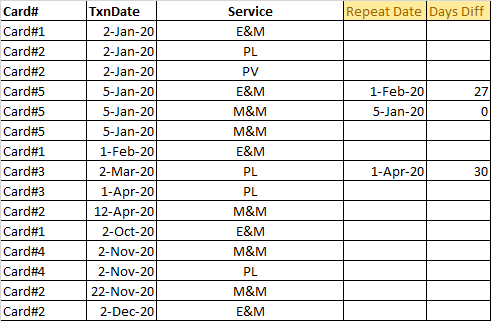Assuming data in Table1
1/ Setup a seperate query, name it i.e. fxComputeRepeatedService and give it the following code:
(inputTable as table, maxDaysDiff as number) as table =>
let
fxShiftColumnByOneRow = (inputTable as table, ColumnToShift as text, optional NewColumnName as nullable text) as table =>
// By Imke Feldman @ https://www.thebiccountant.com/2018/07/12/fast-and-easy-way-to-reference-previous-or-next-rows-in-power-query-or-power-bi/
let
Source = inputTable,
NewName = if NewColumnName = null then "Next_" & ColumnToShift else NewColumnName,
ShiftedList = List.RemoveFirstN(Table.Column(Source, ColumnToShift), 1) & {null},
SourceColumnsAsLists_Concat_ShiftedList = Table.ToColumns(Source) & {ShiftedList},
NewTableFromAboveLists = Table.FromColumns(SourceColumnsAsLists_Concat_ShiftedList, Table.ColumnNames(Source) & {NewName}),
ChangedType = Table.TransformColumnTypes(NewTableFromAboveLists,
{NewName, Type.TableColumn(Value.Type(Source), ColumnToShift)}
)
in
ChangedType,
Source = inputTable,
SortedDate = Table.Sort(Source, {"TxnDate", Order.Ascending}),
ShiftedDate = fxShiftColumnByOneRow(SortedDate, "TxnDate"),
DaysDiff = Table.AddColumn(ShiftedDate, "Days Diff", each
if [Next_TxnDate] = null
then null
else if Duration.Days([Next_TxnDate]-[TxnDate]) <= maxDaysDiff
then Duration.Days([Next_TxnDate]-[TxnDate])
else
null,
Int64.Type
),
RepeatDate = Table.AddColumn(DaysDiff, "Repeat Date", each
if [Days Diff] <> null then [Next_TxnDate] else null,
type date
),
Reordered = Table.SelectColumns(RepeatDate,
Table.ColumnNames(Source) & {"Repeat Date","Days Diff"}
)
in
Reordered
2/ Your main query code:
let
Source = Table1,
GroupedRows = Table.Group(Source, {"Card#", "Service"},
{"CardService", each
if Table.RowCount(_) > 1
then fxComputeRepeatedService(_, 30)
else _,
type table
}
),
CombinedTables = Table.Combine(GroupedRows[CardService])
in
CombinedTables
Not intensively tested but seems to do what you want. Correspong XL/PQ sample avail. here where I ajdusted your mistake + added a few rows for testing purpose
RE. "...can illustrate a 60 & 180 days as well which I can use for other analysis" => Just change 30 with 60 or 180 in main query code line 6.

